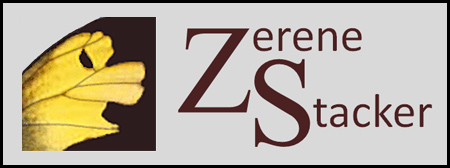Transcript: Video Tutorial #1: Introduction To Retouching
This is a transcript of the video tutorial shown HERE.
One of the most powerful features of Zerene Stacker is its retouching tool, which allows the user to quickly and easily combine the best features of different stacked results, in addition to pulling details from individual source images.
This demonstration will show you how to use most features of the retouching tool.
These include:
- panning and zooming within an image,
- quickly navigating across a large number of input files, and
- flashing between source and destination images to identify areas to be retouched.
The subject for this demonstration is a small fruit fly, originally photographed as a stack of 167 frames through a 10-power microscope objective. Stacks like this are challenging because they have very shallow depth of field in any individual frame, and because the lens’s wide aperture tends to look around foreground structures, often making them appear partially transparent.
We begin this demonstration after the stack has already been run through both major stacking methods, PMax and DMap. Each of these methods has certain advantages. Generally PMax gives less halo and does a better job with overlapping bristles and faint details, while DMap does a better job of preserving the contrast and smooth tones of the original source images. Both methods often have trouble with isolated foreground features, particularly where the background behind them also contains crisp high contrast details.
To make the best possible output image, we need to combine information from several sources. For this demonstration, primary sources will be the DMap output image, the PMax output image, and one of the original input files.
We begin by selecting the DMap output image and menu-selecting Edit > Start Retouching. This internally prepares the image for retouching. It also synchronizes the two image windows, so they automatically stay aligned as the images are zoomed and panned.
At this point we can immediately see several features of the user interface.
- With no keys depressed, the retouching brush displays as a yellow circle. Rotating the mousewheel at this point changes the size of the brush. (The brush size can also be changed by keyboard using the square bracket keys, “[” to make smaller and “]” to make larger.)
- Pressing and holding the spacebar gives you a hand cursor. While the hand cursor is active, pressing and dragging the mouse pans the image, and rotating the mousewheel changes the image zoom.
- Pressing the “s” key temporarily displays the current source image in place of the destination image. Quickly pressing and releasing the “s” key will flash between these two images, allowing you to quickly and easily compare specific areas that may need retouching.
- The source image for retouching can be one of the individual input files, or any output image, including the original version of the output image that we are now retouching.
- Whenever any of the original input files is selected, there is another convenient tool for finding exactly the one that we want. Simply hover the mouse over the source image and press the Shift key. This gives you an up-down navigation cursor. When the up-down cursor is showing, pressing a mouse button and dragging up and down will scroll through the stack of input files.
Note that these features can be combined. For example we can press the “s” key to show the source image in place of the destination image, while simultaneously pressing Shift and dragging the mouse to select a specific input file.
This is particularly useful when the destination image is maximized to occupy the entire working area. By combining the keyboard and mouse actions, practiced users can do all of their retouching in a single maximized window, with very little movement of either their eyes or their hands. This is often the fastest and easiest approach to retouching.
With all this as background, let’s finally do some work!
Again, remember that we have selected the DMap output image as the base for retouching. DMap output often makes a good starting point, but like many depth map images, this particular one has problems with bristles. This is clearly seen in the bottom part of the face. PMax generally handles bristles quite well, so we select the PMax output as a retouching source. Pressing and releasing the “s” key flashes between the two images so that we can see the differences. By selecting an appropriate brush size, we can quickly brush over the offending bristles, to solve most of the problems.
However, one large bristle captures our attention, because it looks partially transparent, like background detail is showing through. To investigate and fix this problem, we select any input file, then press “s” and Shift simultaneously, and use the mouse to quickly navigate through the stack. Once we find the appropriate source image, a quick resizing of the brush and a couple of strokes completes the retouching of this region.
Similar techniques can be used to quickly correct halos and visibility errors over the rest of the image area.
When retouching is complete, we simply Edit > Commit Retouching to capture the retouching into a new output image. Additional retouching can be conveniently performed at a later time by using this retouched image as a basis for further work.
And that’s it — thanks for watching!
